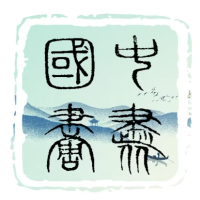江南之地,钟灵毓秀,泰州姜堰,孕育英才。王锁平,壬子岁初降。幼承天性,七龄执笔,临池写心,痴迷翰墨,未染凡俗。及至束发之年,蒙良师指引,窥见丹青妙理。入大学府,潜心研习,然胸中情怀,早若暗潮汹涌,澎湃难抑。
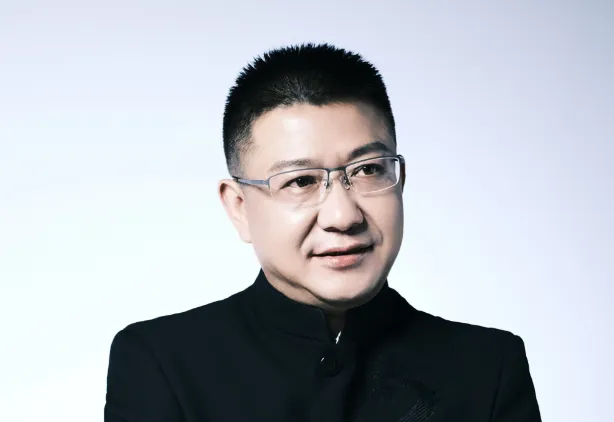
王锁平
王锁平习五体书法,遍涉楷行隶草篆,尤爱文徵明之行书,行云流水,自由舒展,性情相契。先修书法,后习国画,深谙书画同源之理,书法为画骨,画乃书之延,功力深厚,心手双畅。笔墨挥洒间,规矩森然而灵动,流云野鹤,意态萧然。王锁平书艺,笔性沉着,如流云舒卷,似清风拂林。表观洒脱,内含规矩,筋骨暗藏。篇幅连绵,欹正相生,笔断意连,变化多端,规矩严谨而不失灵动,若无意,实有法。其性豪放,洒然不羁,胸中磊落,凝于毫端,挥洒素笺,心迹流露,尽显潇逸。
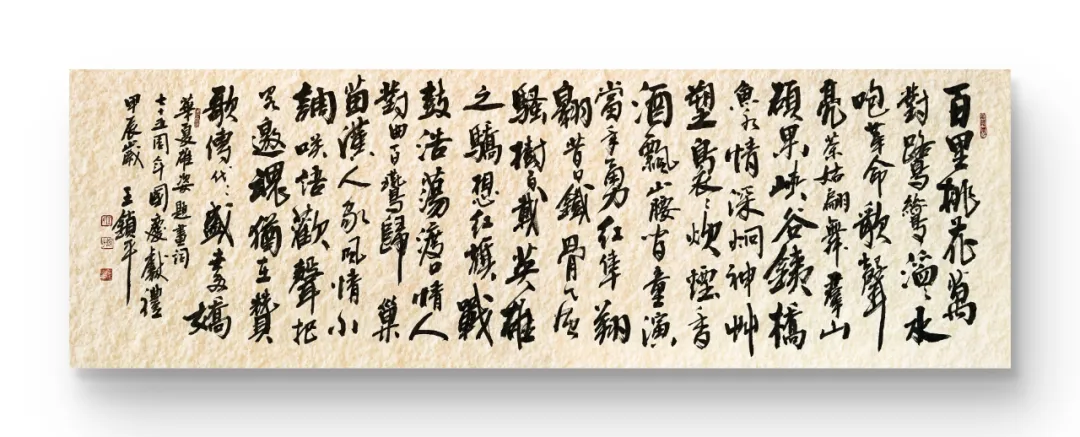
二十载故交评曰:“随性,傲骨,自成天地。”或人视为锋锐,然于艺道,正探幽之资。书画无拘,率性而为,心感所至,笔随意发。言:“吾作,心境之影。”书骨画形,诗魂墨韵,心象幽邃,意在言外,淡而味厚。锁平墨事不染尘垢,神游艺海,于创新博采众长,融会贯通,笔墨与西法透视相合,形神交映,气象万千。此非求名之志,实为真性使然。笔墨本随时代,古法不囿一隅。其道,顺乎自然,厚积薄发,心至墨随,意达形现,妙理于无声处化生。
锁平精研古典诗词,行吟山林,谙古人风雅之韵。每有佳作,必题自撰诗句,或寄情山水,或托意风月,情思渊远,言简意深。笔墨之中,诗意流淌,虚实相生,计白当黑,逸韵天成。画中有诗,诗中有画,观者徘徊其中,若梦若幻,神游其中而不觉归也。每幅丹青,无不寄怀抱素心,流露意境。墨色浓淡间,蕴含万千情思,画之妙处,难以言传,只可心会。其书画交辉,神韵暗含,观者俯仰,恍若游于天地之间,赏之则情动于中,品之则意随心转,斯真妙哉。

王氏之作笔墨坚实,意象澄明。临池三十载,心游艺境,笔底山河层叠,云烟出岫,立体动感,气象万千。古法深蕴,妙探光影透视之道,形色相融,笔墨合璧,凝作天成一卷。用笔或如风过林梢,或似水激石隙,骨线劲挺,散锋随和。皴擦点染,游走其间,心意流转,变幻无穷。山川高远,谷壑幽深,岩峦险峻,涧泉潺潺,烟霞缥缈,意境生发。笔随心动,心随境移,随心所欲而不逾矩,逸韵天成而心自现。墨法更是得心应手,干湿浓淡,随意而发。简处生妙趣,厚处见苍茫。干裂如秋风扫叶,润泽若春雨催花。墨色交映,水光相辉,或浓或淡,层层晕染,一气呵成。虚实相生,厚薄有致,形色相融。随意挥洒,云烟幻化,山河之象,纸上灵动,若见若闻,若隐若现。
王锁平山水,远观巍峨,高峻雄伟;近品绵延,细腻丰盈。山川之势,溪流之清,烟云之幻,层层铺展,意蕴深长。每幅画作,皆心境写照。画中之景,不独眼前实象,更藏心中幽境。工笔写形,刻山石之纹理,绘草木之生机,描流水之灵动,绘山脉之绵延,形神俱备,气韵并生,画面如跃纸上,呼之欲出。傅抱石之抒情,李可染之浑厚,黄宾虹之苍劲,皆不足尽其神韵。工笔之精微,写意之酣畅,传统之深邃,西法之立体,动静之间,虚实之中,藏露相生,妙趣天成。画中云烟流泉,草木苍翠,山石峭拔,飞瀑奔流,笔墨与色彩交织,俱显生机。工笔绘质,写意赋灵,山川草木,宛然如生,景在眼前,境在梦中。画意呈现,若有若无,虚实之间,妙象自生。草木山川,似有灵魂,在无声诉说,蕴藏自然之律动。画中幽境,惚兮恍兮,虚实交融,观者神往,意生无限。其作不拘成法,亦不囿程式。笔墨功深,光影透视、造型色彩,灵动运用,自成一家。观者细品,如游其间,意随境转,令人流连。
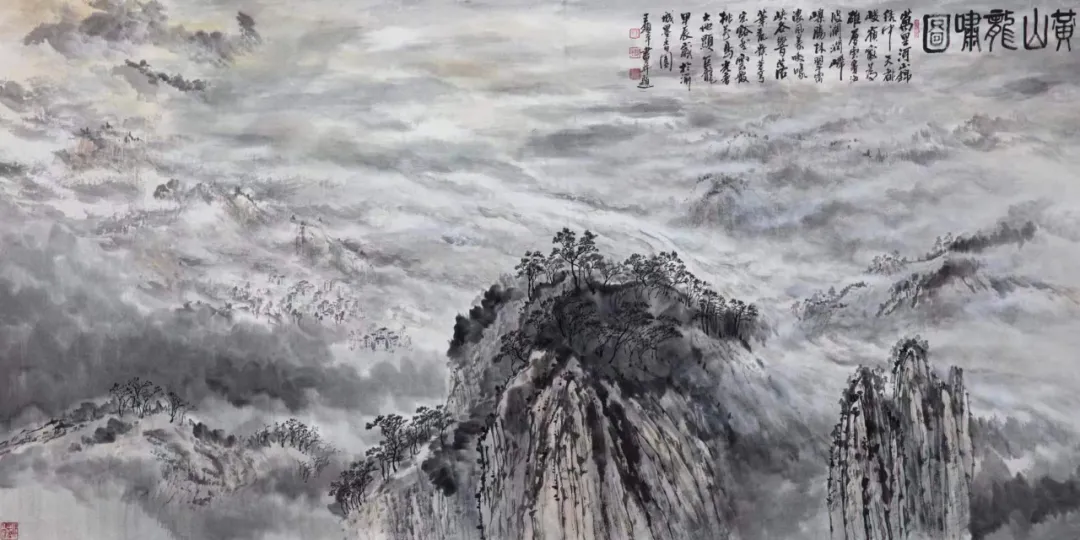
王锁平亦擅绘莲荷接天、老松虬曲、飞鸟凌空,笔墨光影,造型色彩,交融流转。或淡而神旺,或简而意足,或萧疏清逸,或酣畅淋漓,皆妙趣横生。其画“书入其间”,虽无意为之,书画同源之理,已潜移默化于胸。点染、皴擦、勾勒、挥洒,行云流水,笔意纵横,变化无穷。或点或线,或面或形,皆意趣盎然,韵味自成。
王锁平绘荷莲,线条灵动,风神自现。荷姿摇曳,似临风舞袖,出尘而不染,淡泊而自芳。淡墨几许,荷叶层叠,疏影横斜;数笔挥洒,荷花柔美,含韵自生。写意非为形似,神韵方见真性。寥寥几笔,风骨俱现,暗寓君子高洁之志。王氏于笔墨间,寄怀清芬,荷花之绘,犹心境之写。污泥不染,清涟自洁,古人咏叹,志士之节。写意不求形貌,而重心源,每笔蕴意,每墨含情。以少驭多,简而意足,浓淡干湿,虚实相生,笔随心转,墨含灵气。其画若夏日微风,拂面荷香,淡雅萦怀。荷叶疏密相间,或浓或淡,若浮若沉,似风中生灵,气象万千,神韵暗生。锁平书法深厚,笔墨纵横,荷花之动静、阴阳,皆由此而生。画中荷影,非止风物,更是心象。荷之品,画之境,皆寄胸中丘壑,气韵贯通。心手相映,情景相融,荷影非影,心境非境。此中妙理,不在笔下,而在心间。观者临画,若临幽境,荷香暗生,意远情长。
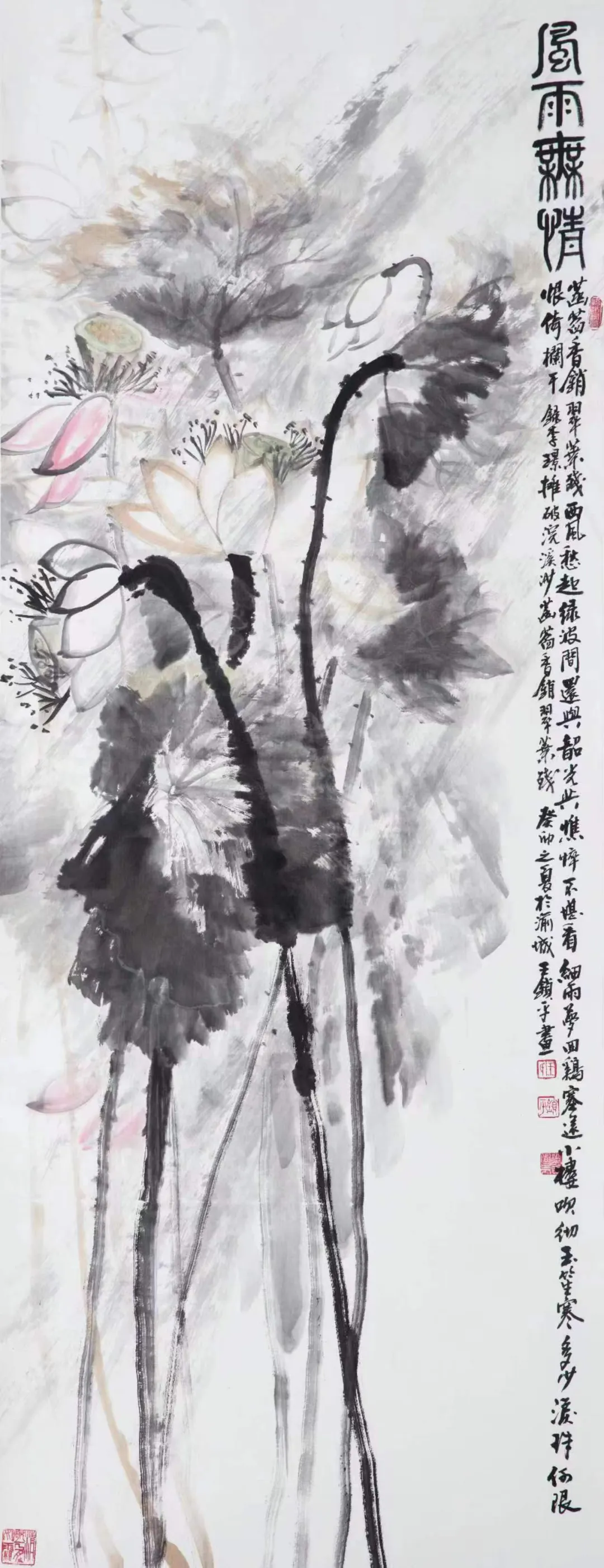
王氏淡泊,不以功名为念。往昔病患缠身,身心失衡,书画遂为栖心之地,遂于笔墨间寻得安定。心无旁骛,潜心研习,得意境之真,终解忧患。今豁达开朗,随性而作,常言:“不求刻意破茧,只在积累成蝶。”随性而行,灵感自至,心境如水,笔墨如风,久积薄发,化境自成。观其画,笔底山川非山川,草木非草木,乃心中气象,情感所寄。天人合一,浑然天成,正是锁平之妙境。


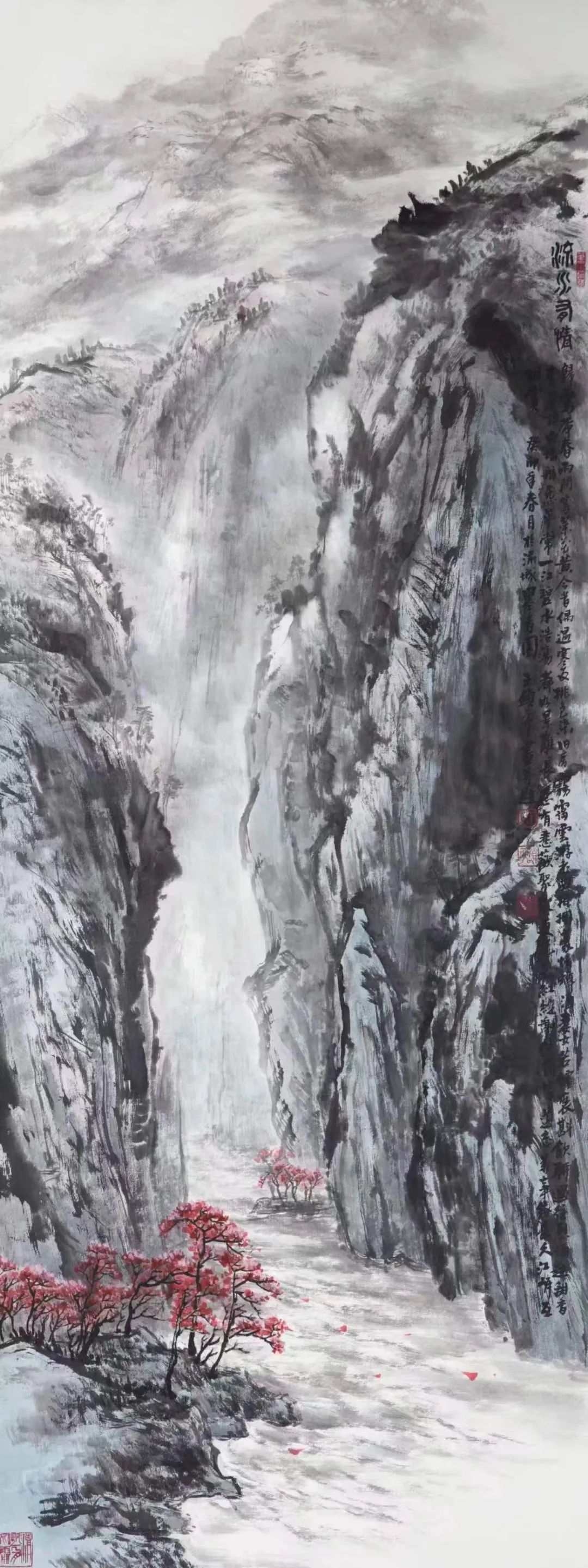
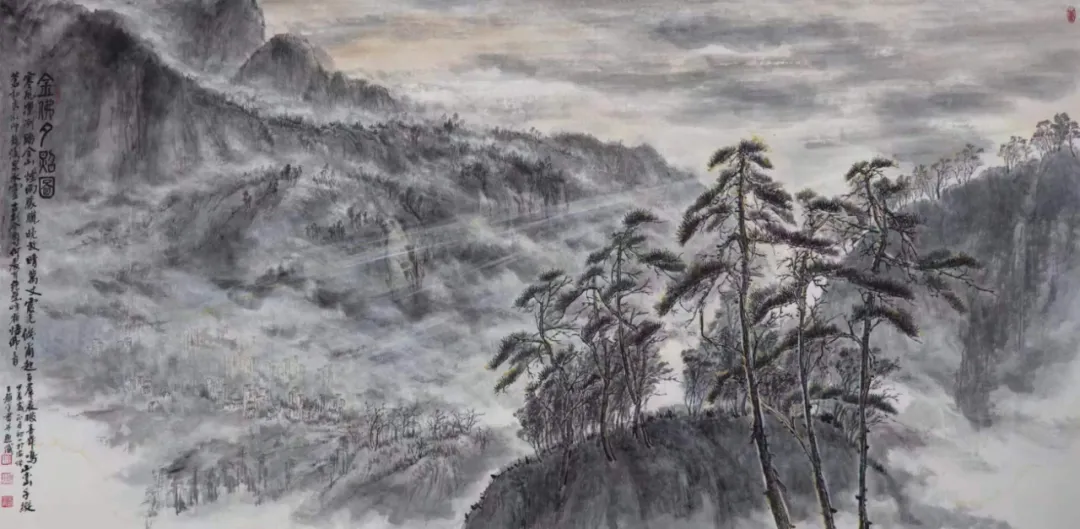

王锁平艺/术/简/介
王锁平,一九七二年三月出生于中国江苏泰州姜堰区(当时泰县农村)。当代艺术巨匠、中国水墨山水的先锋代表,也是当代诗、书、画皆擅长的全才艺术家。出版《中国高等艺术院校名师教学范本》(王锁平山水画作品选、王锁平花鸟画作品选)、《中国当代艺术名家王锁平画谱》。
主要代表作:《毛泽东诗词长卷书法》、《中国75周年国庆献礼诗词书法》、《黄山胜景题画诗书法》、《背影》、《风起云涌图》、《盘江大桥》、《黄山梦幻图》、《黄山日出图》、《静观风云图》、《金佛夕照图》、《潼南精神》等经典名作。作品版权被人民大会堂、中南海等中央机构广泛应用于国宾礼。“荷”为贵系列作品巡展150多个国家,被全球权威媒体誉为世界艺术殿堂顶级大师,入选2023年度全球百强艺术家榜、中国最具收藏价值艺术家榜、2024年荣获国家功勋模范艺术家称号、中国文化走向世界国家形象人物、载入《世界美术教育史》的中国当代唯一巨匠级艺术家。人民日报、中央电视台、中华英才、中华网、央视网、中国新闻联播网、中国新闻网、美国时代周刊、纽约时报、英国卫报、阿联酋国家新闻等数万家全球权威媒体发表名家专栏作品及宣传报道其杰出成就。
Wang Suoping: Unique Charm from the Heart, Freely Expressing Innocence and Authenticity
The land of Jiangnan is rich with beauty and talent, and from Taizhou Jiangyan emerged a remarkable artist. Wang Suoping was born in the mid-autumn of the Renzi year. From an early age, he displayed a natural affinity for art, holding a brush at the age of seven and immersing himself in the study of calligraphy and painting, untouched by worldly concerns. As he grew older, a guiding mentor introduced him to the profound principles of Chinese painting. Entering university, he dedicated himself to intensive study, yet his inner passion had long been like a surging tide, irrepressible and boundless.
Wang Suoping has mastered the five styles of calligraphy, having studied regular, official, cursive, and seal scripts, yet he particularly cherishes the flowing and elegant style of Wen Zhengming’s running script. His strokes move like drifting clouds and flowing water, free and unrestrained, perfectly matching his nature. First, he honed his skills in calligraphy and then delved into traditional Chinese painting, understanding deeply the principle that calligraphy and painting share the same origins. In his hands, calligraphy is the backbone, and painting is its extension; his profound skill is evident as his hand and heart work in perfect harmony. His brushwork, while adhering to strict rules, exhibits a natural fluidity, like clouds and cranes drifting across the sky, exuding a sense of detached elegance. His calligraphy appears relaxed and spontaneous, yet beneath the surface lies structure and discipline. His works stretch seamlessly, balancing tension and relaxation, with strokes that break yet connect in intention. His use of rules, strict yet lively, embodies the essence of following natural law without being constrained by it. His personality is bold and free, his spirit upright and unrestrained, expressing his heart’s landscape with a touch of elegance and ease.
An old friend of twenty years once described him as “free-spirited with a resolute will, carving out his own world.” While some may see this as sharpness, in the realm of art, it is precisely this quality that allows him to explore the depths. Unconstrained in his art, he follows his nature, expressing whatever his heart feels, and his brush follows accordingly. He said, “My works are reflections of my state of mind.” His calligraphy serves as the skeleton, his painting as the form, his poetry as the soul, and his ink embodies the rhythm. His inner visions are profound, conveying meanings beyond words, seemingly simple yet rich in flavor. Wang’s engagement with ink is untainted by mundane concerns; he wanders freely in the ocean of art, drawing inspiration from various traditions and integrating them seamlessly. He combines the traditional Chinese brushwork with Western perspective, merging form and spirit to create a myriad of atmospheres. This is not a pursuit of fame but a manifestation of his genuine nature. His art flows with the times, unfettered by the confines of ancient methods. His approach is one of following nature, accumulating deeply over time, where heart and ink align, intent and form emerge, and profound truths arise silently.
Wang Suoping deeply engages inical poetry, wandering in mountains and forests, attuned to the elegance of the ancients. Whenever he completes a work, he inscribes it with his own verses, sometimes expressing his feelings for nature, sometimes alluding to the moon and breeze, with sentiments profound and words succinct. Within his brush and ink, poetic meaning flows; reality and illusion intertwine, negative space complements the positive, achieving a natural harmony. His paintings contain poetry, and his poetry is imbued with painting; those who view them feel as if they are in a dream, wandering in the scene without realizing it. Each of his paintings is imbued with pure intentions, conveying a serene atmosphere. Between the rich and light ink tones lie countless emotions, the wonders of which are beyond words and can only be felt by the heart. His calligraphy and painting are intertwined, imbued with a hidden grace. Viewers, whether bowing in admiration or lingering over them, feel as if they are traversing the realms of heaven and earth. To appreciate them is to be moved; to ponder them is to let one’s thoughts follow the heart’s direction. Truly, it is a marvel.
Wang’s works are rooted in solid brush and ink techniques, with clarity of imagery. Having practiced by the inkstone for thirty years, he roams freely in the artistic realm. Under his brush, mountains layer upon mountains, clouds rise from valleys, and the scenery appears dynamic and three-dimensional. He integrates ancient methods, skillfully exploring the principles of light and shadow, blending form and color, brush and ink, into harmonious compositions. His strokes, sometimes like wind brushing the treetops, sometimes like water striking rocks, possess firm structure and gentle fluidity. His application of texture strokes and washes flows with his thoughts, ever-changing and boundless. Majestic mountains, deep valleys, rugged peaks, clear springs, and ethereal clouds and mist—all emerge as vivid scenes. His brush follows his heart, his heart follows the scene, and he creates with freedom within bounds. His ink techniques are equally versatile, freely applying wet and dry, rich and light. Simplicity reveals hidden charm, while depth conveys grand vigor. Cracks appear like autumn leaves swept by wind, and moisture spreads like spring rain nurturing blossoms. Ink and water interact, light and color reflect, with layered tones blending seamlessly into one another. Void and solid complement each other, with varying thickness and form coalescing into perfect harmony. His brush flows naturally, clouds and mist take shape, and mountains and rivers come alive on the paper, visible and tangible, yet elusive and ethereal.
Wang Suoping’s landscapes, viewed from afar, are majestic and grand; examined up close, they are intricate and rich. The grandeur of the mountains, the clarity of the streams, the mystique of the clouds and mists, all unfold layer by layer, filled with profound meaning. Each painting reflects his state of mind. The scenes depicted are not just the reality before the eyes but also the hidden realms within his heart. Using fine brushwork, he carves out the texture of rocks, paints the vitality of plants, captures the fluidity of water, and portrays the continuity of mountain ranges. His works combine form and spirit, and the energy and rhythm are palpable, as if they leap from the paper, vividly lifelike. The lyricism of Fu Baoshi, the depth of Li Keran, the vigor of Huang Binhong—all these influences fall short of fully capturing his essence. The precision of his fine brushwork, the exuberance of his freehand style, the profundity of tradition, and the three-dimensionality of Western techniques all merge, with movement and stillness, reality and illusion, concealment and revelation intertwining into a wondrous harmony. In his paintings, clouds and mist flow, vegetation thrives, rocks stand tall, and waterfalls rush, all infused with vitality through the interweaving of brush and color. His meticulous brushwork lends substance, and his freehand style breathes life into the forms, making the mountains and rivers seem as if they are truly present, though the scenes exist both in reality and in dreams. The imagery appears faint yet clear, blending void and solid, with mystical forms emerging naturally. The mountains and rivers, the plants and trees, seem to possess souls, silently conveying the rhythms of nature. The enchanted landscapes within the paintings are ephemeral and elusive, blending reality and illusion, drawing the viewer in and stirring boundless imagination. His works transcend conventions and are unbound by formal constraints. His mastery of brush and ink, his skillful use of light and perspective, his adeptness in form and color, all coalesce to create a unique style. Those who appreciate his paintings feel as if they are wandering through them, their thoughts following the scene, deeply immersed.
Wang Suoping is also skilled in painting lotus flowers reaching towards the sky, gnarled old pines, and birds soaring in flight. His brushwork, the play of light and shadow, the forms and colors, all flow and blend harmoniously. His paintings can be light yet full of spirit, simple yet rich in meaning, sparse yet elegantly clear, or exuberant and lively, each filled with a unique charm. Though he does not consciously integrate calligraphy into his paintings, the principle that calligraphy and painting share the same origin has long been internalized. Dots, texture strokes, outlines, and washes—his brushwork moves like clouds and flowing water, vigorous and unfettered, with endless variations. Whether in points, lines, surfaces, or forms, every stroke is brimming with vitality, every piece possesses its own charm.
In his lotus paintings, Wang Suoping’s lines are agile, capturing the spirit with natural grace. The lotus sways, as if dancing with the wind, untainted by the dust of the world, exuding a quiet fragrance. With just a few strokes of light ink, he layers the lotus leaves, casting shadows that intersect and complement each other; a few more strokes depict the delicate beauty of the lotus flowers, imbued with innate charm. His freehand style does not aim for mere resemblance but captures the true essence and spirit. A few simple strokes reveal the structure and vitality, subtly symbolizing the noble integrity of a gentleman. In his brushwork, Wang conveys purity and fragrance, painting the lotus as an expression of his inner state. Though it grows from muddy waters, it remains unstained and pure, embodying the qualities of a true man, as the ancients praised. His freehand brushwork does not pursue outward likeness but focuses on the source of the spirit, where each stroke holds meaning, and every ink line conveys emotion. Using less to achieve more, his simplicity is full of intent; the interplay of light and dark, wet and dry, real and illusory, follows his heart and the flow of ink. His paintings, like a summer breeze carrying the scent of lotus flowers, leave a subtle and lingering impression. The lotus leaves, with their alternating density, float or sink, like living beings swaying in the wind, full of life and hidden charm. His deep foundation in calligraphy allows his brush and ink to flow freely, with the dynamic interplay of movement and stillness, yin and yang, emerging naturally. The shadow of the lotus in his paintings is not merely a depiction but a reflection of his inner state. The essence of the lotus and the realm of the painting both reside in the mountains and rivers of his heart, their energy flowing unimpeded. His hand and mind are in harmony, the scene and feeling intertwined. The shadow of the lotus is not just a shadow, the state of mind not just a state. The profound truth lies not in the brush but in the heart. Those who view his paintings, as if stepping into a quiet realm, can sense the subtle fragrance of the lotus, their thoughts stretching far and wide.
Wang, with a tranquil heart, does not seek fame or fortune. In the past, he was plagued by illness and physical imbalance, and art became his sanctuary, where he found peace in the world of brush and ink. With unwavering focus, he immersed himself in his studies, ultimately finding the true essence of artistic expression and freeing himself from his burdens. Now, he is open-minded and optimistic, creating freely. He often says, “I do not seek to break free by force, only to accumulate and transform like a butterfly emerging from its chrysalis.” He follows his nature, allowing inspiration to come to him. His mind is like water, his brush like wind, gradually accumulating strength to finally reach a realm of transformation. In his paintings, the mountains and rivers beneath his brush are not merely landscapes, the trees and grasses not merely flora—they are the reflections of his inner landscape and the embodiment of his emotions. The unity of heaven and man, the natural harmony, is precisely the essence of Wang Suoping’s artistic realm.
Wang Suoping: Artistic Profile
Wang Suoping, born in March 1972 in Jiangyan District, Taizhou, Jiangsu, China (then a rural area in Taixian County), is a contemporary master artist and a pioneering representative of Chinese ink landscape painting. He is a versatile artist proficient in poetry, calligraphy, and painting. His published works include Teaching Models of Renowned Professors from China's Leading Art Institutions (Selections of Wang Suoping's Landscape Paintings, Selections of Wang Suoping's Flower and Bird Paintings) and The Painting Collection of Renowned Contemporary Chinese Artist Wang Suoping.
His major works include Calligraphy of Mao Zedong’s Poetry in Long Scroll, Calligraphy of Poems for the 75th Anniversary of the Founding of the People's Republic of China, Calligraphy of Poems on the Majestic Scenery of Huangshan, Back View, Stormy Clouds, Panjiang Bridge, Dreamlike Huangshan, Sunrise over Huangshan, Serenity Amidst the Clouds, Golden Buddha at Sunset, Tongnan Spirit, and otheric masterpieces. The copyrights of his works are widely used as state gifts by central institutions such as the Great Hall of the People and Zhongnanhai. His series The Noble Lotus has toured over 150 countries and has been acclaimed by global authoritative media as the top master in the world of art. He was selected as one of the Top 100 Global Artists of 2023 and one of the Most Collectible Chinese Artists. In 2024, he was awarded the title of National Meritorious Model Artist and recognized as a prominent figure representing Chinese culture to the world. He is the only contemporary Chinese artist of his stature to be included in The History of World Art Education. His exceptional achievements have been featured in prominent media outlets worldwide, including People's Daily, CCTV, Chinese Talents, China.com, CCTV.com, China News Network, Xinhua News Agency, Time magazine, The New York Times, The Guardian, Emirates News Agency, and many more.
